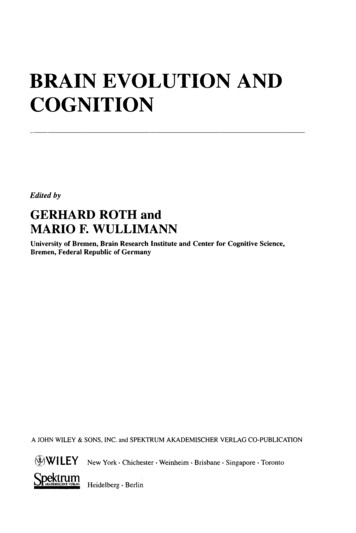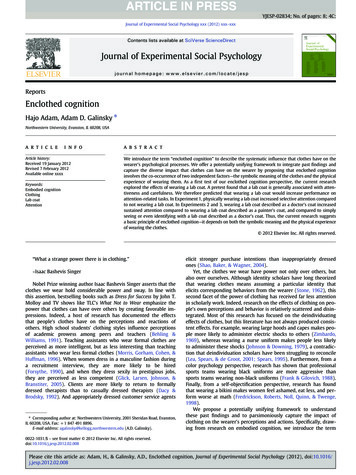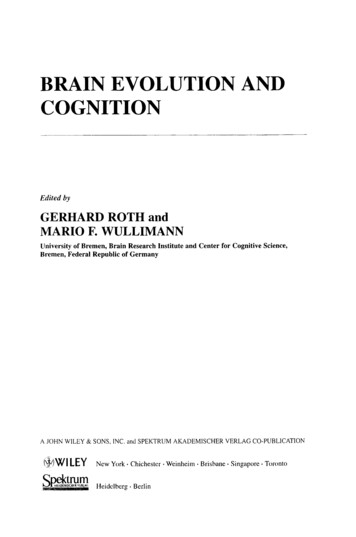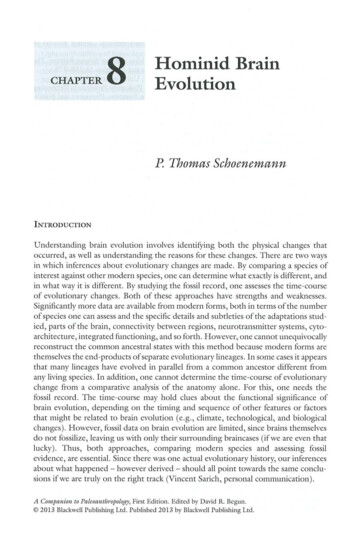
Transcription
BRAIN E V O L U T I O N ANDCOGNITIONEdited byGERHARD ROTH andMARIO F. WULLIMANNUniversity of Bremen, Brain Research Institute and Center for Cognitive Science,Bremen, Federal Republic of GermanyA JOHN W I L E Y & SONS, INC. and S P E K T R U M A K A D E M I S C H E R V E R L A G C O - P U B L I C A T I O N WILEYSpektrumKJLAKADEMISCHER VERIAC.New York Chichester Weinheim Brisbane Singapore TorontoHeidelberg Berlin
ContentsINTRODUCTIONProblems in the study of brain evolution and Cognition1Mario F. Wullimann and Gerhard RothHandicaps in the search for an evolutionary history of vertebrate brainsSilent revolutions emergingThe amniote telencephalon as a case in pointA special position for humans?What is Cognition?References123567PART I D E V E L O P M E N T A L AND A D U L T BRAINO R G A N I Z A T I O N IN E V O L U T I O N1Brain phenotypes and early regulatory genes:The Bauplan of the metazoan central nervous system11Mario F WullimannIntroduction11Comparative phenotypic analysis of metazoan central nervous characters. . . . 13The cladistic framework13A can of worms: Plathelminths, nemathelminths, nemertines14The molluscan controversy20The arthropod CNS, rather than being ancestral to the vertebrate CNS,is equally remote from the basic bilaterian Bauplan as the craniate brain. . 22Deuterostome nervous Systems25Conclusion28Early genes in neural development - Do they teil a different story?30Development and Bauplan of the vertebrate CNS30Early regulatory genes and neuromeres in the vertebrate brain32Early regulatory genes and the insect CNS32Phylogenetic interpretation of molecular genetic and phenotypic data . . . . 34Conclusion36References372The echinoderm nervous System and its phylogenetic interpretation41Thomas Heinzeller and Ulrich WelschIntroductionDescription of Nervous SystemsLarval nervous SystemPostmetamorphotic nervous system: Common features41444445
vi3ContentsPostmetamorphotic nervous system: Group-specific featuresCryptosyringidaInter-class comparison of sensory versus motor functionQuestions of SymmetryCentral part of the bodyBilateral symmetry and segmentation of the armsAre echinoderm arms homologous with bilaterian trunks?Echinoderm ectoneural cord versus chordate neural plateAdditional body axesHydrocoel and notochord - are they convergent or homologous?Locomotion of EchinodermsPhylogenetic AspectsConsistency versus flexibility of regulatory genesGarstang's hypothesisSystematics of echinodermsMissing volution of vertebrate motor Systems77Hans J. ten Donkelaar4IntroductionBasics of vertebrate locomotionPrehensile extremitiesFeatures of the ancestral vertebrate motor systemNeural control of quadrupedal locomotionSupraspinal controlDescending supraspinal pathwaysThe cerebellorubrospinal limb control systemThe special case for sory system evolution in vertebrates113William Hodos and Ann B. ButlerHow many senses?How many cranial nerves?Trends in sensory system evolutionAscending sensory pathwaysNeuroembryology and the evolution of sensory SystemsEvolution of new sensory receptorsEvolution of new primary, secondary, and higher ordersensory nuclei113115116119120122122
Contents5viiThe evolution of sensory specialistsEvolution of central sensory pathwaysThe evolution of new central sensory nucleiThe evolution of sensory mapsLoss of sensory receptors and central pathwaysMechanisms of sensory system evolutionReferences123124125126127130131Evolution of the forebrain in tetrapods135Tom ShimizuIntroductionEvolution of tetrapodsEarly tetrapods - Ancestral amphibiansEarly amniotes - Ancestral reptilesSynapsids - MammalsSauropsids - ReptilesSauropsids - BirdsConclusionForebrain Organization of living tetrapodsAmphibian patternMammalian patternSauropsid patternConclusionEvolutionary history of the tetrapod forebrainEarly tetrapodsEarly amniotesSynapsids and sauropsidsConclusionEnvironmental pressures on the tetrapod forebrainAnamniote pattern versus amniote patternSauropsid pattern versus mammalian patternConclusionReferences6Neocortical 61162163163165169.170171172175176185Rudolf NieuwenhuysIntroductionMajor sensorimotor projectionsControl SystemsReticular, greater limbic and general modulatory inputs toneocortical circuitryThe ascending reticular systemThe greater limbic systemMonoaminergic and cholinergic modulatory Systems185186189192192193194
viii7ContentsCortico-subcortico-cortical association SystemsThe thalamic association systemThe striatal association systemThe cerebellar association systemSummaryReferences195196198199201202Hunting in barn owls: Peripheral and neurobiological specializationsand their general relevance in neural computation205Hermann Wagner8IntroductionEvolutionary position and geographical distribution of the barn owlHunting as a complex behaviorGeneral commentsFormal description of the hunting SituationAdaptations of barn owls to hunting in the nightThe barn owl's brainMorphological adaptations of the owFs brain to hunting andlife at nightPhysiological adaptationsCoincidence detectionFurther brain adaptations subserving sound-localization behaviorDifferences in the representation of acoustic space in diurnal andnocturnal owlsGeneral meaning of coincidence detection and 5206206206208209212Evolution and devolution: The case of bolitoglossine Salamanders237213216218225228228231232Gerhard Roth and David B. WakeIntroductionThe BolitoglossiniThe brain of Salamanders and frogsThe visual system of bolitoglossinesRetina and retinofugal systemTectumThe fate of other sensory SystemsCauses and consequences of simplification in the context ofpaedomorphosisWhat do bolitoglossines teil us about evolution in general and brainevolution in 0
Contents9Evolutionary constraints of large telencephalaix265Gerd Rehkämper, Heiko D. Frahm, and Michael D. MannEvolution -What does that mean?265Brain and brain part size as a heuristic tool266What factors influence brain size or brain part size?268There is no brain size alteration269Brain size alterations are epiphenomena269Brain size is influenced by individual learning270Brain size and brain part size reflect adaptation271Definition of "large telencephala"271Mammals272Telencephala enlarged because of dominance of olfactory orientation . . . 272Telencephala enlarged because of superior spatial Cognition272Telencephala enlarged because of a voluminous isocortex275Isocortex (and therefore, telencephalon) enlarged because ofelaborated somatosensory areas together with a necessity of motorcoordination in a subterranean life276Telencephala enlarged because of multimodal Integration278Birds278Telencephala enlarged because of olfaction278Telencephala enlarged because of spatial Cognition279Telencephala enlarged because of isocortical equivalents280Domesticated animals283Again: Theories of brain size and brain composition285Conclusions288References289PART I IC O G N I T I O N : F R O M N E U R A L BASIS T O B E H A V I O R10 Brain and cognitive function in teleost fishes297Leo S. Demski and Joel A. BeaverIntroductionStudies on Cognition in fishesBrain lesions and cognitive behavior in fishesTelencephalon: Nonspatial learningTelencephalon: Spatial learningCerebellumTectumRelative brain size and development: Implications for cognitivefunction in fishesStudies in minnows (Cypriniformes)Blind and sighted characins297298300300301302303304304306
xContentsThe cichlids of the African great lakesCoral reef percomorphsMicrocircuitry of telencephalic enhancements in selected percomorphs . . . .Area dorsalis telencephali pars lateralis (dorsal part)Area dorsalis telencephali pars centralisArea dorsalis telencephali pars medialisBehavioral studies on the enlarged telencephalon of percomorphsSummary and conclusionsReferences11 Cognition in insects: The honeybee as a study case306307311313317319321323325333Randolf Menzel, Martin Giurfa, Bertram Gerber, and Frank HellsternIntroduction: Brain, behavior, and biology of honeybeesBehavior and biology of honeybeesDesign of an insect brainElementary and configural forms of learning in classical conditioningThe preparation: Classical conditioning of the proboscisextension reflexA cognitive approach to memory dynamicsThe elementary-configural distinctionCognitive aspects of elementary forms of conditioning?Configural forms of conditioningLearning in the natural contextContext-dependent learning and retrievalSerial order in a spatiotemporal domainThe representation of space in navigationVisual discrimination learning in honeybees: Generalization,categorization, and concept formationConclusionBasic Cognition with a small brainThe ecological niche and basic CognitionReferences12 Insect 359360362367Nicholas 7. StrausfeldIntroductionGeneral features of segmental gangliaThe protocerebrum and the preoral brainEvolutionary considerationsGeneral Organization of the protocerebrumThe mushroom bodiesStructureEvolution of mushroom bodies in insectsRelationship to primary sensory neuropils367368372372373375375377378
ContentsMushroom body physiologyRoles of mushroom bodiesThe central complexEvolutionary considerationsOrganization of the central complexCentral complex functionComparisons of brain regions amongst arthropodsMushroom bodiesThe central complexInsect and vertebrate brains comparedEquivalence of insect and vertebrate embryonic forebrainThe adult brainReferences13 Conservation in the neurology and psychology of Cognitionin 95401Euan M. MacphailIntroduction: Complexity in brains and behaviourSpecies differences in intelligenceBirds and mammals comparedThe basal gangliaPaleostriatal lesions and classical conditioning in the pigeonThe archistriatumPosteromedial archistriatum: Fear and avoidanceAnterior and intermediate archistriatum: Parallels with isocortexCortexOlfactory cortexHippocampal complexIsocortical analogues/homologuesConclusionsReferences14 Multimodal areas of the avian forebrain—Blueprintsfor 27431Onur Güntürkün and Daniel DurstewitzThethemeWorking memory and prefrontal cortexAvian brain and CognitionDetails of the machineThe decline of a memory störeSimulation of the machineLooking insideReferences431432434437439442449450
xiiContents15 Cognition of birds as products of evolved brains451Juan D. Delius, Martina Siemann, Jacky Emmerton and Li umerosityEpilogueReferences16 What can the cerebral cortex do better than other partsof the brain?451456461467472477483491Almut SchüzIntroduction491Basic Connectivity of the isocortex492The cerebral cortex and CognitionComparative aspectsBrain size and Connectivity494497497Allocortex and reptilian cortexReferences17 Evolution and complexity of the human brain: Some organizingprinciples498499501Michel A. Hof manIntroductionEvolution of brain sizeEncephalization in primatesGeneral constraints on brain evolutionEvolution and geometry of the cerebral cortex501502505507510Design principles of neuronal Organization514Biological limits to Information processingConcluding remarksReferences51551851918 The evolution of neural and behavioral complexity523Harry J. JerisonIntroductionVigilance and attention: An old-fashioned viewCosts and attentionCosts and brainsBrain size in living vertebrates: Allometry and encephalizationExceptionsEarly avian and mammalian encephalization523525526531533535539
ContentsProgressive encephalization in mammalsMore on neural InformationNeural and behavioral complexityWhy some brains are big: What do big brains do?References19 The evolution of consciousnessxiii542544546547551555Gerhard RothPhenomenology of consciousnessThe neurobiological basis of the different states and appearancesof consciousnessCognition and consciousness in animalsAnimal brains and human brainConsciousness and 79580583
IntroductionPROBLEMS IN T H E S T U D Y OF BRAINE V O L U T I O N AND COGNITIONMario F. Wullimann and Gerhard Roth, University of Bremen,Brain Research Institute and Center for Cognitive ScienceWhy a book about the evolution of brains and their cognitive functions? Although theevolution of nervous Systems and brains has been much investigated, it still is adebated and unsettled topic, as is the question about the relationship between brainsand cognitive functions. Therefore, we organized an international Symposiumentitled "Brain Evolution and Cognition" at the University of Bremen in December,1994. Many scientists followed our invitation to present their current ideas on thattopic in Bremen. In the wake of that meeting, the plan emerged to publish a book, andalmost everyone involved agreed to make a contribution. A few more authors notinitially involved with the Symposium were asked to join the book project (and theykindly agreed to do so) and so here we are at last.In our introductory remarks to the Symposium, the contributors were encouraged tosearch for answers to the following questions: Can one draw principles of brainevolution? Why did some brains become large and complex, and others small andsimple and still others remained as they were for hundreds of millions of years?Where, how, and why did Cognition evolve? Is there any definable relationshipbetween cognitive functions and brain structures and function? What are the forcesthat drove the evolution of cognitive functions (external, internal, or both)?Before we let the chapter authors provide answers to these questions, we discusssome problems in the study of brain evolution and Cognition.HANDICAPS I N T H E S E A R C H F O R A N E V O L U T I O N A R Y H I S T O R Y O FV E R T E B R A T E BRAINSThe case of horses is one of the finest examples of what paleozoology, paleobotany,paleoclimatology, and paleoecology can do in reconstructing the phylogeny andevolutionary history of a certain animal group (Carroll, 1988). The reason why thereis so much more known on the evolution of horses than on the evolution of vertebratebrains is obvious: There is an almost complete fossil record in the case of horses.This primary source of information is missing in the case of brains and represents thefirst handicap for the search for an evolutionary history of brains. The only
2Problems in the Study of Brain Evolution and Cognitionpaleontological information on fossil brains is available in the form of endocasts andhas mostly been used in the context of brain weight/body weight analyses. Althoughthis approach yields fascinating results in its own right—particularly in the primateand other mammalian cases (van Dongen, 1998; Jerison, this volume, Chapter 18)—it cannot go beyond the primary data and explain the emergence of particularcytoarchitectonic differences, let alone their related functional implications that arosein the course of vertebrate brain evolution. Unfortunately, as in the case of most softorgans, there is no paleontological record of the fine structure of brains. Thus,historical brain research is mostly left with neontological data from extant speciesand its analysis using the phyletic method. A second handicap becomes apparentwhen we look at the drastically different functional interpretations of, for example,the bird versus the mammalian brain that have been given during the past Centurybased on comparative descriptive neuroanatomy. The sometimes breathtaking beautyof diverse histological and cytoarchitectonic patterns in various vertebrate brains(Nieuwenhuys et al., 1998) apparently has gone along with conflicting evolutionaryexplanations (i.e., these differences have an immense potential for divergentinterpretation). Thus, it is clear that descriptive neuroanatomy alone is not a sufficientsource for a stringent functional explanation of brain structures. One of the greatestProblems in that respect has been that certain preconceived views—deeply rooted inthe teleological preevolutionary concept of a scala naturae (i.e., nature's attempt atarriving stepwise to perfection going from lower to higher vertebrates)—were soughtto be confirmed in the sometimes great apparent morphological differences in brainstructure (e.g., between fishes and mammals). The idea was that of a successiveaddition of major brain parts and related increasingly complex functions going fromfish to human in evolution (see critical reviews by Northcutt, 1981; Roth, 1994;Wullimann, 1997). Naturally, the study of behavior and Cognition has beeninfluenced by such preconceived notions Coming from comparative neuroanatomy.However, research of the past three decades has increasingly shown that there aremore commonalities in general brain Organization and behavior of vertebrates thanwas previously believed.SILENT REVOLUTIONS EMERGINGThree events had a substantial effect on a new understanding of vertebrate brainevolution in the second part of the twentieth Century. First, the explosivedevelopment of neurobiological methodology (e.g., the invention of many newinvestigative tools such as immunohistochemistry, neuronal tracing agents,improved extracellular and intracellular neurophysiology, and refined protocols forcontrolled behavioral studies) marked massive progress for various disciplines of theneurosciences. At the same time, the quantity and diversity of data available forcomparative evolutionary brain studies has been tremendously enlarged, and thevalidity of interpretations has been improved. Second, the introduction of Hennigiancladistics (Hennig, 1966; Northcutt, 1984; compare Wullimann, this volume,
The Amniote Telencephalon As A Case In Point3Chapter 1) into the comparative discussion as a tool for analyzing neural charactersaltered the way one deals with the interpretation of evolutionary change in brains(compare, for example, a treatise on the evolution of the mammalian isocortex byNorthcutt and Kaas, 1995). Finally, the immense new input Coming fromdevelopmental molecular genetic studies led to the discovery of many early activeregulatory genes and developmental pathways that directly bear on the vertebratebrain Bauplan and continue to have a tremendous effect on evolutionary brainstudies (Heinzeller and Welsch; Strausfeld; Wullimann, this volume, Chapters 2, 12,and 1, respectively).T H E A M N I O T E T E L E N C E P H A L O N AS A C A S E IN POINTIn browsing through many chapters of this book, it becomes clear that a centralquestion in the discussion on vertebrate brain evolution is how the large anddifferentiated telencephalon of birds compares to that of mammals: Are therecomparable structures and functions in their respective pal Ii um and subpallium, andwhat, if any, is their common origin in phylogeny? There is a long and winding roadof comparative neuroanatomy starting at the beginning of the twentieth Century on thatsubject (nicely summarized by Striedter, 1997). However, by midcentury, the eminentAmerican neurobiologist of that time, C. Judson Herrick, succinctly summarized thethen accepted view (which became the traditional one for later decades) in 1956 in hisbook The Evolution of Human Nature: "The bird's cerebral hemispheres are composedalmost entirely of the enormously enlarged corpora striata, which are concerned almostexclusively with stereotyped reflex and instinctive behavior." Thus, the suspected lesswell developed plasticity of behavior, learning capacity, and other cognitive abilities ofbirds compared to mammals was considered beautifully consistent with twoneuroanatomical Undings, the first one being that birds have a massive intraventriculartelencephalic nuclear neural mass, the dorsoventricular ridge, resembling the relativelymuch smaller basal ganglia of mammals. Second, the Situation seemed in reverse whenthe pallium (especially the isocortex or dorsal pallium) was considered: Birds have arather small structure (Wulst) in comparison to the large isocortex of most mammals(Hofman; Nieuwenhuys; Schüz, this volume, Chapters 17, 6, and 16 respectively).However, views changed dramatically as new data became available on the intrinsicneurochemical, hodological, and neurophysiological Organization of aviantelencephalic areas during the 1960s. Harvey Karten, a pioneer of a new school ofcomparative neurobiology, proposed that most of the avian dorsoventricular ridge infact functionally corresponds to isocortex of mammals and that the avian basal gangliaare equally represented by a limited territory at the base of the telencephalon, muchlike the Situation in mammals (Karten, 1969; Shimizu, this volume, Chapter 5). Thisview is indeed more consistent with the mammal-like, fascinating learning andcognitive capabilites of the vocalizing African gray parrot Alex (Pepperberg, 1990).Cognitive abilities are partially equally well developed in pigeons (Delius, Siemann,Emmerton, and Xia; Macphail, both this volume, Chapters 15 and 13, respectively),
4Problems in the Study of Brain Evolution and Cognitionwhich even display a suite of critical anatomical, neurochemical, neurophysiological,and behavioral features together composing an equivalent to a prefrontal cortex ofsorts (Güntürkün and Durstewitz, this volume, Chapter 14; compare also Wagner, thisvolume, Chapter 7, for the special case of the barn owl).However, as convincing as the neuroanatomical similarities and functionalcorrespondences might be, the question of whether or not they are homologous restson data to be gained in taxa outside birds and mammals (Northcutt and Kaas, 1995).Only a comparative evaluation, including an outgroup comparison, will eventually teilus which characters might be considered ancestral for amniotes and which are derivedfor birds or mammals. Not unexpectedly, the Situation is complex. Clearly, the aviantelencephalic morphotype (i.e., dorsoventricular ridge versus isocortex) is present inother sauropsids (Ulinski, 1983), and many of the diagnostic features that led to therecognition of basic pallial regions, such as a medial (hippocampus; Rehkämper,Frahm, and Mann, this volume, Chapter 9), lateral (olfactory) and dorsal pallium(isocortex), as well as of subpallial divisions (e.g., septum, caudatoputamen,pallidum), are seen in nonavian sauropsids as well (Butler and Hodos, 1996).Although many forebrain features typical of amniotes are recognized meanwhile inanamniotes as well (Wullimann, 1997; Demski and Beaver, this volume, Chapter 10),the search for the ancestral amniote condition remains a matter of controversy. On themotor side (basal ganglia), recent investigations point to a detailed correspondence ofstructure and function between the amniote and the amphibian brain (Marin et al.,1998; ten Donkelaar, this volume, Chapter 3). However, the ancestral condition forsensory and integrative Systems is less well established, and there may be manyindependently derived features, such as dominance and detailed functional propertiesof visual Subsystems in the bird and mammalian cases (Hodos and Butler, this volume,Chapter 4). An eminent problem for a comparative analysis is that amphibians—theoutgroup of sauropsids and mammals—are paedomorphic in their brain morphologyto various degrees and might not reliably be used for establishing the ancestraltetrapod condition (Roth et al., 1993; Roth and Wake, this volume, Chapter 8).A third event that revived comparative neurobiology recently is the new alliancebetween molecular developmental and evolutionary studies. Many early active regulatory genes and developmental pathways clearly are common to all bilaterian animalsand their brains even outside the vertebrates (for a critical review of the relationhipbetween genes and brain phenotype, see Wullimann, this volume, Chapter 1). Thereare equally amazing correspondences between invertebrate and vertebrate brains onthe anatomical (Strausfeld, this volume, Chapter 12) and the behavioral level (Menzel,Giurfa, Gerber, and Hellstern, this volume, Chapter 11). To return to the vertebrateränge, early regulatory gene expression patterns led to the proposition of a new(neuromeric) model of the vertebrate brain Bauplan (Puelles and Rubenstein, 1993)that has proven to be highly fruitful in a number of evolutionary questions. Inparticular, early forebrain gene expression patterns shed new light on the evolution ofthe amniote brain, challenging Karten's theory outlined previously: The dorsoventricular ridge may be homologous to part of the mammalian amygdala and claustrumrather than to isocortex (Puelles et al., 1999), as similarly proposed based on neuralcircuitry before (Bruce and Neary, 1995; compare Shimizu, this volume, Chapter 5).
A Special Position for Humans?5Some of the discussed pervasive similarities between different vertebrate brains(and even between all bilaterian brains) should not be misunderstood to advocate agenerality of animal brain Organization. A true comparative neurobiology will finallyexplain not only the commonalities but also the various specializations of vertebratebrains (Nieuwenhuys et al., 1998). The search for the evolutionary emergence ofthose vertebrate nervous structures subserving complex behavior, includingCognition, is far from being completed and the discussion about it continues. Thepresent book lends vivid testimony to that notion.A S P E C I A L P O S I T I O N F O R HUMANS?In traditional Western thinking, humans are situated well above the animal kingdom;they have qualities and capabilities that are either unique or greatly exceed thosefound in animals. However, during the nineteenth Century, it became undeniable thatat least with regard to their anatomy, human beings are representatives of one out ofmany evolutionary lines in the sense that in every aspect of their body they arevertebrates, mammals, primates, and great apes. This certainly was a shockingconclusion: Human beings are animals.At the same time, most biologists (Charles Darwin being among the notableexceptions) continued to believe that at least with respect to spiritual or cognitiveabilities, humans are still far superior to animals: Only humans have mind andconsciousness, only humans can think and plan. However, unless these abilities wereassumed to be supernatural qualities, they had to be derived from properties of thebrain. Thus, a necessary conclusion was that—unlike the rest of the body—thehuman brain had unique properties in comparison to other vertebrate brains. Manycandidates for such unique properties have been discussed, including the absolute orrelative size of the entire brain, of the cerebral cortex, of the prefrontal cortex, thepossession of speech centers, and the degree of lateralization.However, even that view has been questioned by modern comparative andevolutionary neurobiology. The human brain appears to be a "typical" primate brain,and while in some respects (e.g., degree of encephalization) it exceeds most, i f notall, other animals, no fundamental gap is apparent between the brains of nonhumananimals and Homo sapiens. Furthermore, in many lines of invertebrate and vertebrateanimals, anatomically and functionally complex and large brains have evolvedindependently. Thus, the human brain is not even unique in that respect. I f we stickto the assumption that the cognitive or spiritual abilities of humans derive from brainproperties, three explanations remain: (1) The exact properties that are the basis forunique abilities of the human brain have not yet been discovered; (2) these abilitiesoriginate from a special combination of brain properties that taken by themselves arenot unique; and (3) there are no unique cognitive or spiritual abilities of humans.
6Problems in the Study of Brain Evolution and CognitionWHAT IS COGNITION?The term Cognition has a long and diverse tradition in philosophy and psychology.Until recent times, this term was often restricted to perceptual, mental, emotional,and volitional states as far as these were connected to awareness and consciousness.Later, the term Cognition has been applied to all those psychological functions thatexceed simple stimulus-response relationships (D.O. Hebb) and/or refer to theacquisition or generation of meaning (E.C. Tolman). According to a much-citeddefinition by Ulric Neisser, Cognition "refers to all processes by which the sensoryinput is transformed, reduced, elaborated, stored, recovered and used" (Neisser,1967). In terms of cognitive psychology, this includes faculties such as patternrecognition, attention, short- and long-term memory, the representation andOrganization of knowledge (visual images, categorization, semantic Organization,etc.), and complex cognitive skills such as language, comprehension and memory fortext, problem solving, expertise and creativity, and decision making (Reed, 1996).In another much-read textbook of cognitive psychology by Anderson (1990),Cognition—as the target of cognitive psychology—is identified with the "nature ofhuman intelligence and how people think" and at the same time with "informationprocessing." Of course, the latter interpretation is too narrow and not very useful inthe context of comparative neuroscience. First, it is unclear, what is meant by "humanintelligence," and it is even more unclear what could be meant by "informationprocessing." There is no logically satisfactory distinction between informationprocessing in the sense of signal processing and in the sense of processing andgeneration of meaning. While there is a well-elaborated information theory for theformer (e.g., that developed by Shannon and Wever; 1949), no such theory exists forthe latter. This is most regrettable, because what brains do is not just processing ofneural Signals, but the generation of meaningful states. One of the greatest challengesof co
Adaptations of barn owls to hunting in the night 209 The barn owl's brain 212 Morphological adaptations of the owFs brain to hunting and life at night 213 Physiological adaptations 216 Coincidence detection 218 Further brain adaptations subserving sound-localization behavior 225 Differences in the representation of acoustic space in diurnal and










